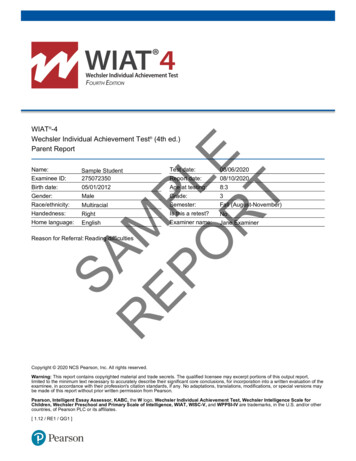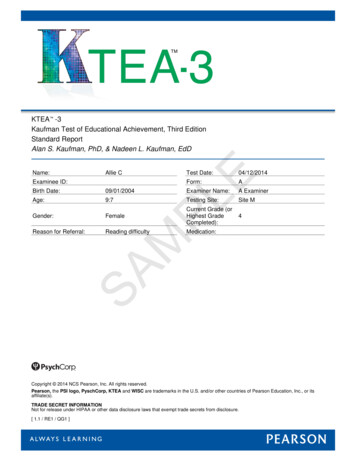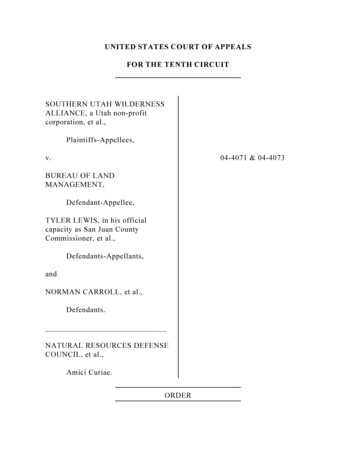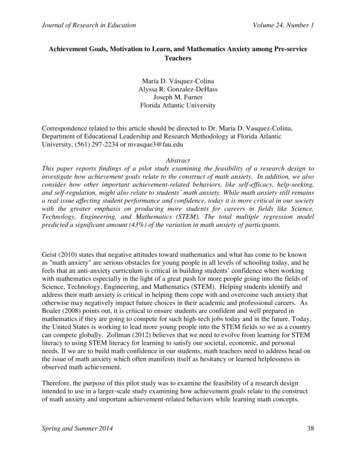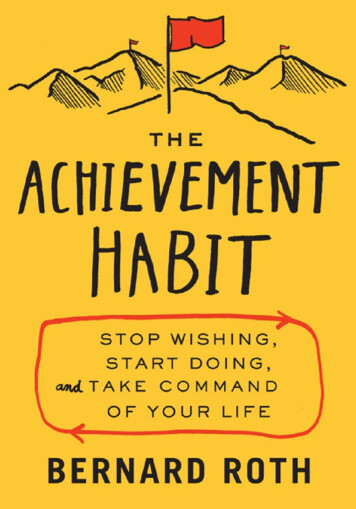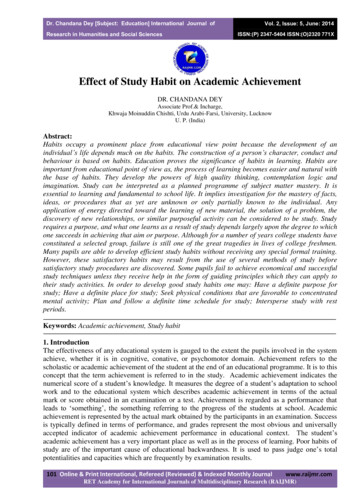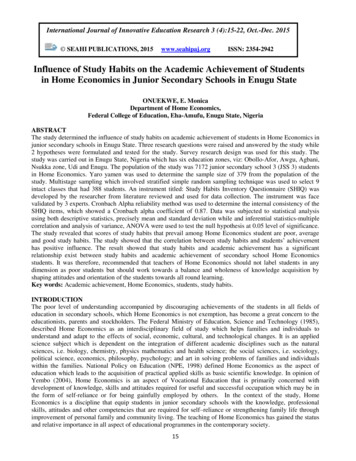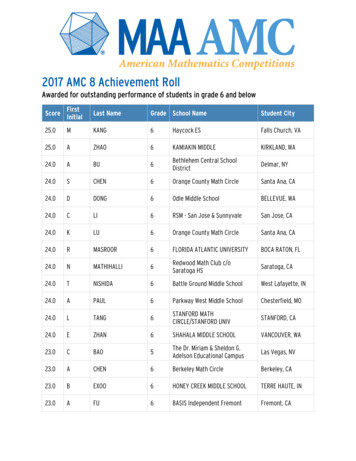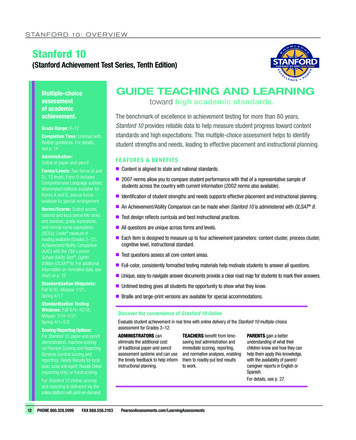
Transcription
S ta n f o r d 10 : o V E r V I E WStanford 10(Stanford Achievement Test Series, Tenth Edition)Multiple-choiceassessmentof academicachievement.Grade Range: K–12Completion Time: Untimed withflexible guidelines. For details,see p. 14Administration:Online or paper-and-pencilGuide teachinG and learninGtoward high academic standards.The benchmark of excellence in achievement testing for more than 80 years,Stanford 10 provides reliable data to help measure student progress toward contentstandards and high expectations. This multiple-choice assessment helps to identifystudent strengths and needs, leading to effective placement and instructional planning.Fe ATuReS & BeNeFiTSForms/Levels: Two forms (A andD), 13 levels; Form D includesComprehensive Language subtest;abbreviated editions available forForms A and D; secure formsavailable by special arrangementnContent is aligned to state and national standards.n2007 norms allow you to compare student performance with that of a representative sample ofstudents across the country with current information (2002 norms also available).nIdentification of student strengths and needs supports effective placement and instructional planning.Norms/Scores: Scaled scores,national and local percentile ranksand stanines, grade equivalents,and normal curve equivalents(NCEs); Lexile measure ofreading available (Grades 2–12);Achievement/Ability Comparison(AAC) with the Otis-LennonSchool Ability Test , EighthEdition (OLSAT 8). For additionalinformation on normative data, seechart on p. 13nAn Achievement/Ability Comparison can be made when Stanford 10 is administered with OLSAT 8.nTest design reflects curricula and best instructional practices.nAll questions are unique across forms and levels.nEach item is designed to measure up to four achievement parameters: content cluster, process cluster,cognitive level, instructional standard.nTest questions assess all core content areas.nFull-color, consistently formatted testing materials help motivate students to answer all questions.nUnique, easy-to-navigate answer documents provide a clear road map for students to mark their answers.nUntimed testing gives all students the opportunity to show what they know.nBraille and large-print versions are available for special accommodations.Standardization Midpoints:Fall 9/30; Midyear 1/21;Spring 4/17Standardization TestingWindows: Fall 9/9–10/18;Midyear 1/14–1/31;Spring 4/1–5/3Scoring/Reporting Options:For Stanford 10, paper-and-penciladministration, machine scoringvia Pearson Scoring and ReportingServices (central scoring andreporting); Ready Results for localscan, score and report; Results Online(reporting only) or hand scoringDiscover the convenience of Stanford 10 OnlineEvaluate student achievement in real time with online delivery of the Stanford 10 multiple-choiceassessment for Grades 3–12.ADMiNiSTRATORS caneliminate the additional costof traditional paper-and-pencilassessment systems and can usethe timely feedback to help informinstructional planning.TeACheRS benefit from timesaving test administration andimmediate scoring, reporting,and normative analyses, enablingthem to readily put test resultsto work.For Stanford 10 Online, scoringand reporting is delivered via theonline platform with print-on-demand12PHONE 800.328.5999LearningAssessCap.indb 12FAX 888.556.2103PAReNTS gain a betterunderstanding of what theirchildren know and how they canhelp them apply this knowledge,with the availability of parent/caregiver reports in English orSpanish.For details, see p. 10 2:34 PM
ac h i eve m e ntS ta n f o r d 10 : a d M I n I S t r at I o n o P t I o n SAdministrAtion optionsTeST LeVeLSReCOMMeNDeD LeVeLSGradeFallSpringKSESAT 1SESAT 21SESAT 2Primary 12Primary 1Primary 23Primary 2Primary 34Primary 3Intermediate 15Intermediate 1Intermediate 26Intermediate 2Intermediate 37Intermediate 3Advanced 18Advanced 1Advanced 29Advanced 2 or TASK 1Advanced 2 or TASK 110TASK 2TASK 211TASK 312TASK 3The concepts and skills assessed byeach level of Stanford 10 are thoseordinarily taught during the secondhalf of any given year and the first halfof the following year. This midyear-tomidyear configuration—with studentstested in the spring of one grade andthe fall of the next—provides a morefocused assessment and greateropportunity to monitor academicgrowth. At the high school levels,where the TASK levels assess basicskills, a single level is appropriate foruse in both the fall and spring of thesame school year.Coming Fall 2010!Common Core StandardsAlignment StudyVisit:Stanford10.com/AlignmentSTANFORD 10 NORMS20022007Norms NormsPaper:NationalnTASK 3CatholicnTASK 3PrivatenLocalnnnnOnline:FORMSNationalnForms A and D are identical with the exception of the format of the Comprehensive Language subtest.The Form A Language subtest (for Primary 1–TASK 3) uses a traditional approach that measureslanguage proficiency through the assessment of language mechanics and expression. The FormD Comprehensive Language subtest (for Primary 1–TASK 3) uses a comprehensive approach thatassesses language proficiency in a more holistic fashion through actual writing processes.CatholicnPrivatenLocalnCOMPLeTe BAT TeRieSFOR FORMS A AND DThese include full-length versions ofall subtests.ABBReViATeD BAT TeRieSAND SuBTeSTSIncludes a subset of items from allComplete Battery subtests, except Listening.Form AForm DForm AForm sMathematicsMathematicsLanguage(Traditional test)ComprehensiveLanguage(Integrated test)Language(Traditional test)ComprehensiveLanguage(Integrated eningScienceScienceScienceScienceSocial ScienceSocial ScienceSocial ScienceSocial SciencePHONE 800.328.5999LearningAssessCap.indb 13FAX 888.556.2103nProfessional Developmentavailable for Stanford 10Pearson also provides professionaldevelopment training sessions onbest practices in using Stanford 10results and analyzing the data tosupport student progress. For details,see pp. 139/15/10 2:34 PM
14KTKTSeSAT 2GRADeK.5–K.5PHONE 800.328.5999LearningAssessCap.indb 14FAX 888.556.2103230 2123 hrs.32 min.3023342458282523302050303030210 1893 hrs.9 408020202050308040304230724036304010020T298 265338 2954 hrs.55 min.4040401154013030KPrimary 2GRADe2.5–3.5318 295358 3255 hrs.25 min.4040202530T303030KPrimary 561230193019240 2033 hrs.23 min.302330205030302030702040254025316 280396 3305 hrs.30 min.4545404630764838305411430KPrimary 561230193019240 2013 hrs.21 min.302330205030302030702040254025322 280402 3305 hrs.30 12051282614304430193019220 1873 hrs.7 min.3023302050303020305040254025292 260372 3105 hrs.10 51282614304430193019220 1873 hrs.7 min.3023302050303020305040254025292 260372 3105 hrs.10 min.4845404832804840305484Kintermediate 1 intermediate 2 intermediate 04535205070T302050282614304430193019220 1863 hrs.6 min.3023302050303020305040254025292 260372 3105 hrs.10 min.4845404832804840305484KAdvanced 30193019220 1853 hrs.5 min.3023302050303020305040254025292 260372 3105 hrs.10 min.4845404832804840305484KAdvanced 0 1602 hrs.40 min.302330302030503040254025222 180302 2303 hrs.50 min.4840484030548450KTASK 0 1602 hrs.40 min.302330302030503040254025222 180302 2303 hrs.50 min.4840484030548450KTASK 2GRADe10.0–10.9NOTe: Stanford 10 allows flexible testing times. The testing times indicated above are guidelines to help administrators and teachers plan. * Basic Battery Administration without Science and Social Science.K No. of items T Time in MinutesComprehensive Lang. (Form D)Total Testing TimeComplete Battery—Multiple-Choice SubtestsSounds and Letters40304025Word Study SkillsWord Reading30153025Sentence Reading3030Reading VocabularyReading ComprehensionTotal Reading7045 100 80Mathematics40304030Mathematics Problem SolvingMathematics ProceduresTotal MathematicsLanguageSpellingListening To Words and Stories 40304030ListeningEnvironment40304030ScienceSocial ScienceBasic Battery*150 105 180 140Complete Battery190 135 220 1702 hrs.2 hrs.Total Testing Time15 min.50 min.Comprehensive Lang. (Form D)Abbreviated Battery—Multiple-Choice SubtestsWord Study SkillsWord ReadingSentence ReadingReading VocabularyReading ComprehensionTotal ReadingMathematicsMathematics Problem SolvingMathematics ProceduresTotal l ScienceAbbreviated BatteryTest LevelsSeSAT 1GRADeK.0–K.5STANFORD 10 : SCOPe & SeQueNCe403020406050T25231430443030193019200 1602 hrs.40 min.302330232030503040254025222 180302 2303 hrs.50 min.4840484030548450KTASK 3GRADe11.0–12.9S ta n f o r d 10 : a d M I n I S t r at I o n o P t I o n SPearsonAssessments.com/LearningAssessments9/15/10 2:34 PM
ac h i eve m e ntS ta n f o r d 10 : C o n t E n t a r E acontent AreARe ADiNGThe Reading subtests measure a broad spectrum of essential reading components and are aligned withIRA/NCTE standards, state standards, and the National Assessment of Education Progress (NAEP).Reflecting a balanced, developmental curriculum and sound instructional practices, these subtestsassess the following areas at appropriate grade levels: phonemic awareness, decoding, phonics,vocabulary, and comprehension.Stanford 10 places an emphasis on assessing foundation skills that are critical to early literacy. TheSounds and Letters subtest closely reflects reading research findings on the importance of phonemicawareness and phonics. Word Study Skills and Sentence Reading are evaluated across a broader agerange than in previous editions. This assessment of literacy development in the early grades helps ensurethat students are progressing at every stage on the road to literacy.Reading Comprehension SubtestThe Stanford 10 Reading Comprehension subtest is based on research about the contexts and activitiesthat are most effective for reading instruction and assessment. The Stanford 10 framework involves threemajor purposes for reading (literary, informational, and functional) and multiple modes of comprehension(initial understanding, interpretation, critical analysis, and awareness and usage of reading strategies).Authentic reading selections commissioned from published authors of children’s and young people’sliterature help create a level playing field for all students and reflect diverse multicultural themes toappeal to students of varying backgrounds, experiential levels, and interests.here are some reasons tohave norm-referenced tests(NRTs) in your toolbox: Local assessments cancomplement the state assessment. National norms compare individualstudent, building, and districtperformance with the nation asa whole. Not only is this uniqueinformation, but also NationalPercentile Ranks are broadlyunderstood scores. NRTs efficiently cover fivemeasures in one test—reading,math, science, social studies,and language. With NRTs, it is possible tomonitor growth over time,providing convincing evidenceof improvement by following theprogress of students from yearto year.Students who take the full-length Reading Comprehension subtest at Primary 1–TASK 3 levels canreceive a Lexile score. The Lexile Framework defines and sequences reading materials in termsof difficulty and allows you to identify customized reading lists for students based on their readingachievement. For information about the use of Lexiles, see PearsonLexile.com.Authentic Reading SelectionsStanford 10 is the only standardizedachievement test to provide readingselections written expressly forStanford 10 by authors of children’sand young people’s literature. Theseauthentic selections create a levelplaying field for all students, and theyinclude a variety of topics and diversecultural themes that will appeal tostudents of varying backgrounds,experiential levels, and interests.PHONE 800.328.5999LearningAssessCap.indb 15FAX ents159/15/10 2:34 PM
S ta n f o r d 10 : C o n t E n t a r E aMATheMATiCSThe Mathematics subtests align with the NAEP and measure concepts and processes based on theNational Council of Teachers of Mathematics Principles and Standards for School Mathematics (PSSM)and state standards. Concepts assessed include number sense and operations; patterns, relationships,and algebra; geometry and measurement; and data, statistics, and probability. Questions also evaluateprocesses in computation and representation; estimation; mathematical connections; and reasoning andproblem solving. To enhance test interpretation, the subtests provide consistency in names of contentclusters across levels.Mathematics Problem Solving measures the skills and knowledge necessary to solve problems inmathematics. Mathematics Procedures measures the ability to apply the rules and methods of arithmeticto problems that require arithmetic solutions.Both standard and metric rulers are used in the Mathematics Problem Solving and Mathematics subtestsfor the Primary 1–TASK levels. A mathematics reference sheet that provides the formulas necessaryto solve problems is included for the Advanced and TASK levels. Calculator use is an option in theMathematics Problem Solving subtest beginning at the Intermediate 1 level and in the Mathematicssubtest at the TASK levels.L ANGuAGeAligned with IRA/NCTE standards and state standards, the Stanford 10 Language subtest measuresstudents’ achievement in applying the principles that form effective writing. From word- and sentencelevel skills to whole composition features, the subtest engages students in real-life activities. Stanford 10offers a choice of Language subtests to suit different language arts instructional approaches.The Traditional Language subtest (Form A) measures proficiency in mechanics and expression in threedifferent sections. The first section measures language mechanics (capitalization, punctuation, andusage) with questions that resemble an actual editing task with a variety of embedded errors. Thesecond section assesses language expression as students demonstrate their understanding of sentencestructure. The third section provides language expression items that include objectives typically evaluatedin the direct assessment of writing.An alternative Comprehensive Language subtest (Form D) provides an integrated test that replicatesthe writing process as closely as possible in a testing situation. This subtest measures pre-writing,composing, and editing in a holistic fashion that resembles authentic writing tasks.SPeLLiNGThe Spelling subtest assesses objectives based on the phonetic and structural principles taught at eachgrade level. At Primary 1, the subtest is dictated and students choose from three options. Beginning atthe Primary 2 level, the spelling items reflect real-life editing tasks because they are presented in contextrather than as isolated words. Each spelling item consists of one sentence with three underlined words.Starting at Primary 3, an additional “No Mistake” option is offered, reinforcing the authenticity of thetask. The misspellings used reflect students’ most common spelling errors.16PHONE 800.328.5999LearningAssessCap.indb 16FAX ents9/15/10 2:34 PM
ac h i eve m e ntS ta n f o r d 10 : C o n t E n t a r E aLiSTeNiNG COMPReheNSiONStanford 10 helps assess both listening vocabulary and comprehension at K–Grade 9 levels inrecognition of the importance of listening skills in literacy development, instruction, and everyday life. TheListening subtests emphasize listening strategies and provide a wide variety of selections that includesmulticultural representation.In the Listening Vocabulary section, students demonstrate recognition of the common meanings ofspoken words encountered in various types of activities. The Listening Comprehension section usesdictated selections and questions that reflect the listening materials students hear in school and outsideof the classroom. This section parallels the Reading Comprehension subtest, using literary, informational,and functional texts to measure the same modes of comprehension: initial understanding, interpretation,and critical analysis and strategies.SCieNCeThe Science subtest assesses students’ understanding of the life, physical, and earth sciences, and thenature of science with questions that elicit problem solving and inquiry using a basic understanding ofscience. Reflecting current science practice and research, this subtest aligns with the National ScienceEducation Standards (National Research Council), the Benchmarks for Science Literacy (AmericanAssociation for the Advancement of Science), and state standards.Students must use reasoning skills throughout the subtest to reach answers. These skills includeestimating, making simple calculations, seeking patterns, making observations, recognizing causeand effect, reading standard instruments, and drawing conclusions. Students are challenged to applyfoundation concepts and skills as they think through questions.SOCiAL SCieNCeThe Social Science subtest measures the concepts important for the development of citizenship andstrongly emphasizes critical thinking skills. Giving equal attention to history, geography, political science,and economics, the subtest maintains a balance between national and international issues. It reflectscurrent social studies standards, practices, and research and is aligned with the National Council for theSocial Studies (NCSS) Curriculum Standards for Social Studies and state standards.Using the National Standards for History as a guideline, the history questions focus on the history of theUnited States, Western civilization, and non-Western people and societies who share our interdependentworld. Geography questions, which are based on the Geography for Life: National Geography Standards,cover the themes of location, places, human-environment interaction, movement, and region.The political science component helps assess students’ basic understanding of the U.S. system ofgovernment as outlined in the National Standards for Civics and Government. The economics questionsare based on the Voluntary National Content Standards in Economics.PHONE 800.328.5999LearningAssessCap.indb 17FAX ents179/15/10 2:34 PM
S ta n f o r d 10 : S C o r E r E P o r t SSTANFORD SCALe ALLOWS yOu TO MONiTORSTuDeNT GROWThThe Stanford Scale expresses student performance across all test levelsof a subtest or total score. For example, the Reading Comprehensionsubtest is linked across 11 test levels (Primary 1–TASK 3), forming onecontinuous scale that makes it possible to compare scores from testlevel to test level. This scale is especially helpful for comparing studentperformance in a particular subject area over time.scoring & reporting servicesStanford 10 helps educators make data-driven decisions. A range ofuser-friendly score reports, designed with the input of administratorsand teachers across the country, supports teaching, learning, andaccountability requirements. The reports include narrative summaries,process and cluster summaries, and graphic displays to clarifythe student’s performance and guide planning and analysis.(See pp. 19–22 for sample score reports.)The Stanford Scale offers an objective, consistent tool to monitor studentachievement across years and multiple assessments. Many of our tests arelinked to this scale. From broad-based assessment to classroom diagnosticevaluation, teachers and administrators can relate student performance to acommon metric and monitor students’ educational development.Administrators obtain critical data to document and monitor theprogress of all children and to disaggregate results according tofederal mandates.Stanford Scale Scores AvailableSuBTeST OR TOTALParents better understand their child’s achievement level and getdirection for home involvement.Teachers receive specific information to support instructional planningfor individual students and the class as well as to improve their teaching.SeSATPrimary–AdvancedSounds andLettersWord Study SkillsReADy ReSuLTSWord ReadingWord Reading/Reading VocabularyReadingVocabularySentenceReadingSentence Reading/Reading ComprehensionReadingComprehensionDesigned for use by those who scan or score at the school or district office,Ready Results provides a complete online secure system for immediatelyviewing results and creating customized reports. (See p. 23 for samplereports.) Offering many unique features, Ready Results allows you to:Total ReadingTotal ReadingTotal ReadingTASKMathematics ProblemSolvingnDisaggregate and organize data, and view multiple assessments onone reportnCustomize the data elements that appear on reportsnTrack student performance over time and flag under- or overperforming studentsnControl access to the teacher level, create customize views, anddevelop “Quick Reports” for all users to viewMathematics ProceduresMathematicsEnvironmentListening toWords andStoriesTotal MathematicsMathematicsSpellingSpellingLanguage Form ALanguage Form ALanguage Form DLanguage Form DReSuLTS ONLiNeScienceScienceSocial ScienceSocial ScienceResults Online, a web-based service, gives you quick, flexible accessto Stanford 10 data when the test is scored via Pearson scoring andreporting services. (See pp. 24–25 for sample reports.)Results Online enables you to:EnvironmentListeningThinking SkillsThinking SkillsFor example, using a Stanford 10 multilevel norms booklet, an educator can comparepercentile ranks and stanines for students who take SESAT 2 Sentence Reading andthen take Primary 1 Reading Comprehension at a later time. It is not possible, however,to compare a Reading Comprehension scaled score to a Mathematics scaled score. Eachsubtest and total has its own system of scaled scores.For a demo of Stanford 10 Results Online, visitStanford10Results.com18PHONE 800.328.5999LearningAssessCap.indb 18FAX 888.556.2103nImmediately disaggregate your student data at the school or district levelnCreate customized reports for individual studentsnOrganize your data based on your specific needs—such as bydemographic variables or by student scores for specific subtests—via easy-to-use functions for querying, sorting, content clustering,and reportingnCreate as many customized options as you need by selecting from a listof statistics, scores, content, composites, and demographics, includingthose required by NCLB (gender, race/ethnicity, IEP, LEP, and low SES)To learn more about which reporting tool best fits your needs,please see pages 15/10 2:34 PM
ac h i eve m e ntS ta n f o r d 10 : S C o r E r E P o r t ShOMe RePORTThe Home Report is intended for parents. It is alsoavailable in Spanish and via Stanford 10 Online.PHONE 800.328.5999LearningAssessCap.indb 19FAX ents199/15/10 2:34 PM
S ta n f o r d 10 : S C o r E r E P o r t SSTuDeNT RePORT WiTh CLuSTeRSStudent reports provide essential information aboutstudent mastery of academic standards which helpteachers make informed curricular and instructionaldecisions resulting in improved student achievement.This report is also available in Stanford 10 Online.20PHONE 800.328.5999LearningAssessCap.indb 20FAX ents9/15/10 2:35 PM
ac h i eve m e ntS ta n f o r d 10 : S C o r E r E P o r t SGROuP RePORTGroup reports provide information about the overallstrengths and weaknesses of a group of students atthe class, school, or district level. These are useful incurricular and program planning. This report is alsoavailable in Stanford 10 Online.PHONE 800.328.5999LearningAssessCap.indb 21FAX ents219/15/10 2:35 PM
S ta n f o r d 10 : S C o r E r E P o r t SSuMMARy ReSuLTS Summary performance results at the school or district level Quick access to NCLB disaggregated resultsSuMMARy ChARTS Display of disaggregated results by demographic variables and content categories Charting capability for displaying national percentile ranks across groupsMASTeR LiST OF TeST ReSuLTSThis report is also available inStanford 10 Online.22PHONE 800.328.5999LearningAssessCap.indb 22FAX ents9/15/10 2:35 PM
ac h i eve m e ntS ta n f o r d 10 : r E a dY r E S U Lt SReADy ReSuLTSnTop 10 Percent: Quicklyidentify students forgifted or interventionprograms—in alphbeticalor rank orderReADy ReSuLTSnStudent Multi-Test:View individual studentprogress over timePHONE 800.328.5999LearningAssessCap.indb 23FAX ents239/15/10 2:35 PM
S ta n f o r d 10 : r E S U Lt S o n L I n EReSuLTS ONLiNeSummary Results:nSummary performanceresults at the school ordistrict levelnQuick access to NCLBdisaggregated resultsReSuLTS ONLiNeSummary Charts:n Displayof disaggregatedresults by demographicvariables and contentcategoriesn24Charting capabilityfor displaying nationalpercentile ranks acrossgroupsPHONE 800.328.5999LearningAssessCap.indb 24FAX ents9/15/10 2:35 PM
ac h i eve m e ntS ta n f o r d 10 : r E S U Lt S o n L I n EReSuLTS ONLiNeindividual Results—Cluster:nAnalysis of student performance by content areasand standardsn Specificstrengths and weaknesses among diversepopulations with drill-down capabilitiesPHONE 800.328.5999LearningAssessCap.indb 25FAX ents259/15/10 2:35 PM
S ta n f o r d 10 : S U P P o r t M at E r I a L SsUpport mAteriALsTO heLP STuDeNTS PRePARePractice TestsPractice tests, which were standardized with a national sample, help reduce test anxiety by familiarizingstudents with test direction, sample items, and answer coding.TO heLP TeACheRS iNTeRPReT AND APPLy TeST ReSuLTSCompendium of instructional StandardsThis resource describes the structure of Stanford 10 according to the content standards and cognitiveprocesses the items measure.Guide for Classroom PlanningThis guide shows teachers how to interpret and use test results to group students for instruction, evaluateachievement, set instructional priorities, and plan parent-teacher conferences. Included are sample testquestions with annotations and a complete list of objectives to help teachers understand what is tested andhow it is tested. Definitions of various test scores and types of norms are also provided.Strategies for instruction: A handbook of Performance Activities, Second editionThis handbook helps teachers reinforce instruction on basic curriculum objectives for students in Kindergartenthrough Grade 12. The activities, which emphasize processes and strategies, reflect the content and processclusters measured by Stanford 10. Included are activities for Reading, Mathematics, Language Arts, Science,and Social Science that engage students as they solve problems and discover answers.Guide for Organizational PlanningThis manual helps principals, program directors, and other administrators use Stanford 10 test results to assistwith program evaluation, measure growth in achievement, develop in-service programs for test interpretation,and provide updated information to the public. A review of basic measure concepts and a bibliography also areincluded.TO COMMuNiCATe WiTh PAReNTSPreview for ParentsThis booklet outlines the purpose of Stanford 10 and explains how parents can help their children prepare.Brief descriptions and sample questions for each content area help inform parents about the skills and abilitiesmeasured. Separate versions are available for each level of SESAT through Primary 3. Also available is oneversion is for all Intermediate levels, one version for both Advanced levels, and one version for all TASK levels.understanding Test ResultsParents and students will appreciate this useful resource, which briefly describes why standardized tests areadministered and how the results can be used. The booklet, printed in English and Spanish, includes samplescore reports and explains how to interpret them. (Also available in Spanish.)Stanford 10 home ReportThe Stanford 10 Home Report gives parents ideas for home activities to help reinforce their children’s learning.(See sample, p. 19)26PHONE 800.328.5999LearningAssessCap.indb 26FAX ents9/15/10 2:35 PM
(Stanford Achievement Test Series, Tenth Edition) LearningAssessCap.indb 12 9/15/10 2:34 PM. . SAT 2 GRAD e K.5–K.5 K T Primary 1 50 GRAD e 1.5–2.5 K T Primary 2 GRAD e 2.5–3.5 K T Primary 3
